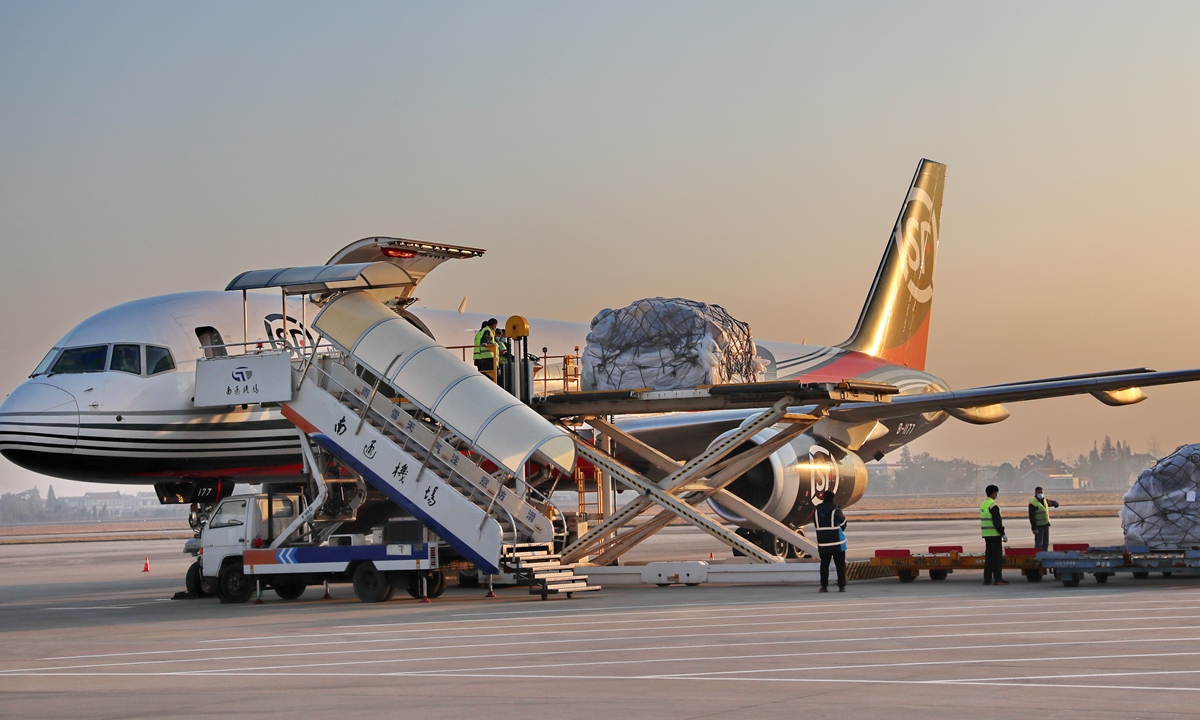
A Boeing 757 freighter loaded with cargo by SF Airlines arrives at Nantong airport in East China's Jiangsu Province. Photo: CFP
As the IMF warned of "longer-than-expected" disruptions on global supply chains posed by the COVID-19 and cut down growth forecast for global economy, concerns are growing over the severeness of the worldwide problem and its potentially profound pressure on global trade and economic growth, with countries scrambling to find a fix.
As the world's biggest trading nation, China is also facing a series challenges resulted from the disrupted supply chains; however, its economy remains very resilient and the government is actively addressing the challenges, Chinese businesses and analysts told the Global Times on Wednesday.
The IMF said on Tuesday that in addition to the recent rise in energy and commodity prices, investors have highlighted the possibility that supply chain disruptions and shortages of labor and materials may be more persistent than currently anticipated. It slightly lowered its forecast for global GDP growth this year to 5.9 percent.
"Pandemic outbreaks in critical links of global supply chains have resulted in longer than expected supply disruptions," wrote Gita Gopinath, chief economist at the IMF, warning of increasing risks.
Chinese businesses, including factories and traders, are also feeling the brunt of the disruptions on the global supply chain, in addition to other challenges, including power restrictions and surging raw material prices.
In the home appliance industry, for example, most factories signed one-year contracts, and they are now turning down new orders in the face of unprecedented pressure from not being able to digest soaring raw materials costs, Hong Shibin, deputy executive director of the marketing committee of the China Household Electrical Appliances Association, told the Global Times on Wednesday.
"Raw material costs increased by at least 30 percent this year, making it difficult for factory owners who signed long-term contracts with foreign clients to make profits," said Hong.
Other issues like port congestion overseas are also creating challenges for factories and traders, as they cannot delivery orders to clients around the globe on time or face sky-high shipping rates.
Recently, congestion at some US ports has exacerbated container shortages and pushed up freight rates, and some ports have approached Chinese companies for solutions. One recent case was the port of Baltimore in the US state of Maryland, which ordered four Neo-Panamax container cranes made by Chinese port equipment maker Shanghai Zhenhua Heavy Industries Co, following a two-month journey from China to ease low efficiency at the US port.
The ongoing pandemic in some countries in Southeast Asia has also disrupted the production of some multinational companies such as Foxconn and pushed them to bring back some of their work to the Chinese mainland to ensure smooth and safe production, according to media reports.
For example, although major domestic shipyards have seen increased orders in the past months, they are under mounting pressure in terms of profits. From January to September, new ship orders reached 54.156 million tons, an increase of 223.3 percent year-on-year, data from the China Association of the National Shipbuilding Industry showed.
Iron ore is one example. A sharp rise in iron ore prices began in November last year, driven by a collective rally in commodity prices due to global monetary easing, and irrational international price mechanisms that favor industry monopolists, even though China is the major consumer of iron ore.
However, Chinese officials have moved swiftly in addressing those issues, including rising commodity prices and power shortages. For example, it has recently moved to increase coal output and imports to ease power shortages. More importantly, the Chinese economy remains very resilient in the face of the challenges, experts said.
The suspension of supply abilities in some countries in the emerging manufacturing hub of Southeast Asia due to the pandemic and disruptions in the global supply chain has highlighted the resilience and reliability of China's supply chain, Wang Jun, chief economist with Zhongyuan Bank, told the Global Times.
Reflecting such a resilience, Chinese official data showed on Wednesday that China's exports grew 28.1 percent in September from the previous year, up 3.9 percentage points from August, significantly beating market expectations, despite the challenges.
"China has overcome its shortcomings in the supply chain over the past two to three decades, and built a comprehensive and stable one that today powers the world," which has not been undercut by disruptions posed by COVID-19, Cao Heping, an economist at Peking University, told the Global Times on Wednesday, noting that China has actually consolidated its crucial role in the global supply chain during the pandemic.




